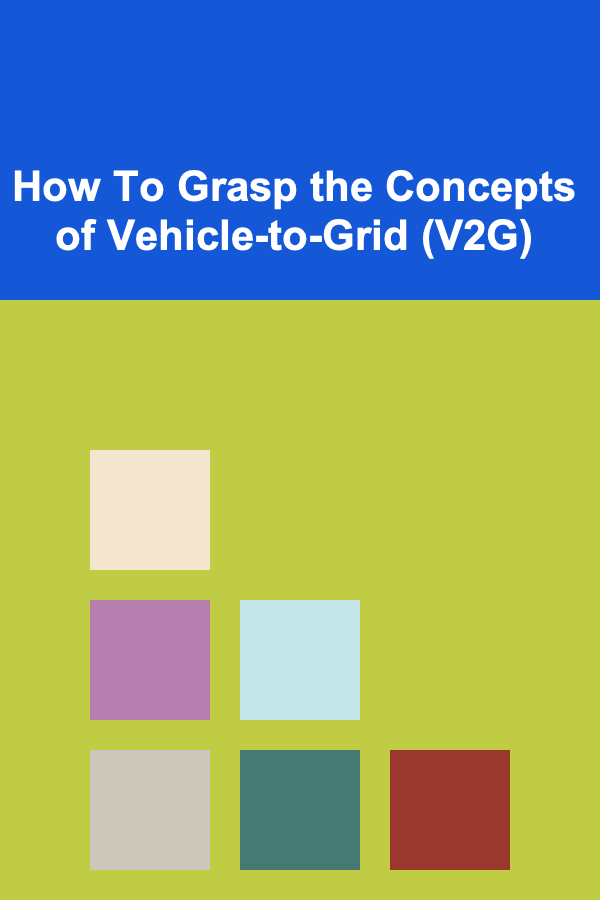
How To Grasp the Concepts of Vehicle-to-Grid (V2G)
ebook include PDF & Audio bundle (Micro Guide)
$12.99$10.99
Limited Time Offer! Order within the next:

The concept of Vehicle-to-Grid (V2G) is a revolutionary idea that has the potential to transform how we think about electric vehicles (EVs), energy storage, and the future of the grid. V2G technology allows electric vehicles to not only draw power from the grid but also send power back to it, creating a bi-directional flow of energy. This article delves deeply into understanding V2G, its technological foundation, its benefits, challenges, and the role it could play in the future of sustainable energy systems.
Understanding the Basics of Vehicle-to-Grid (V2G)
What is Vehicle-to-Grid (V2G)?
Vehicle-to-Grid (V2G) is an emerging technology that allows electric vehicles (EVs) to interact with the power grid in a more dynamic way. Traditional electric vehicles can only draw power from the grid to charge their batteries. However, with V2G, these vehicles can also feed energy back into the grid, creating a two-way flow of electricity.
This bi-directional flow of power is made possible by the integration of a specialized charging station, called a bi-directional charger, that enables both charging and discharging of electricity from the EV battery. This process allows EV owners to use their cars as mobile energy storage units, providing a potential backup power source for homes or businesses, and supporting the grid during periods of high demand.
How V2G Works
V2G technology involves the following key components:
- Electric Vehicle (EV): The vehicle, which is equipped with a rechargeable battery, acts as both a consumer and a provider of electricity.
- Bi-directional Charging Station: This device enables the two-way flow of electricity, allowing energy to be transferred both from the grid to the vehicle and from the vehicle back to the grid.
- Grid Connection: The power grid itself, which serves as the central point for energy distribution, is responsible for both receiving and supplying electricity to the vehicle.
When an EV is plugged into a V2G-enabled charger, it charges its battery from the grid as needed. At times when the grid is under stress or in need of additional power, the EV can discharge its stored energy back into the grid. This discharge can be controlled in real-time based on grid demands and the individual needs of the EV owner.
The Technological Foundation of V2G
Smart Grids and the Role of V2G
For V2G to function effectively, it must be supported by a "smart grid." A smart grid is an upgraded electrical grid that uses digital technology to monitor and manage the flow of electricity from all generation sources to meet the varying electricity demands of consumers. It involves two-way communication between utilities and consumers, allowing for real-time adjustments based on demand, supply, and energy storage.
Smart grids are essential for V2G because they allow for the coordination between various EVs, the bi-directional charging stations, and the central power grid. This coordination is needed to determine when to charge or discharge an EV, based on factors such as grid stability, electricity prices, and the EV's state of charge. Without smart grid technology, V2G would be difficult to implement on a large scale, as it would require complex management of electricity flows and interactions between multiple energy sources.
The Charging Infrastructure
The core technology enabling V2G is the bi-directional charger, which allows the exchange of energy between the grid and the EV. Traditional electric vehicle chargers are only capable of transferring electricity in one direction---into the vehicle. In contrast, bi-directional chargers can transfer energy in both directions, allowing the EV to supply power back to the grid when necessary.
The development and installation of bi-directional charging stations are crucial to the wide adoption of V2G technology. These chargers are equipped with advanced communication protocols to interact with the grid and monitor the state of the vehicle's battery. Additionally, these chargers need to be compatible with a range of EVs, as different manufacturers may use different battery systems and charging interfaces.
Energy Storage Systems and Battery Management
V2G also relies heavily on energy storage systems and advanced battery management technologies. The EV's battery must be capable of being charged and discharged rapidly and efficiently, without causing significant wear or degradation over time. To manage the life cycle of the battery, manufacturers must implement intelligent battery management systems (BMS) that can optimize the charging and discharging process to ensure long-term battery health.
Additionally, V2G systems require intelligent software to manage the flow of electricity between the vehicle and the grid. This software must account for various factors such as energy demand, available capacity, and grid stability to ensure that energy is transferred efficiently and safely.
The Benefits of V2G
V2G technology offers a number of potential benefits, not only for the grid but also for consumers, utilities, and the environment.
1. Grid Stability and Demand Response
One of the most significant advantages of V2G is its potential to improve grid stability. The grid is subject to fluctuations in demand, particularly during peak periods. These fluctuations can cause imbalances that lead to power outages or the need for costly energy imports. V2G can help mitigate these issues by providing a distributed source of energy storage.
When demand is high and the grid is under stress, EVs connected to V2G systems can discharge stored energy back into the grid, helping to balance supply and demand. This process, known as demand response, can reduce the need for fossil fuel-based power plants to ramp up generation during peak periods, thereby reducing carbon emissions.
2. Energy Independence and Cost Savings
For EV owners, V2G offers the potential for energy independence. By storing energy in their vehicle batteries, consumers can reduce their reliance on the grid, especially during times of high electricity prices. For example, an EV owner might charge their vehicle when electricity prices are low (e.g., during the night) and then discharge the energy back into the grid or use it to power their home during peak hours.
Moreover, consumers can potentially earn money by participating in V2G programs, where they are compensated for providing power back to the grid. These incentives could make EV ownership more attractive and financially beneficial in the long term.
3. Renewable Energy Integration
V2G can also help support the integration of renewable energy sources such as solar and wind into the grid. Renewable energy generation is intermittent, meaning that it can fluctuate depending on weather conditions and time of day. V2G can act as a buffer by storing excess renewable energy when production is high and releasing it when production is low. This could lead to a more stable and reliable renewable energy supply, reducing the reliance on non-renewable power sources.
4. Environmental Benefits
By optimizing energy usage and enabling better integration of renewable sources, V2G can contribute to reducing the overall carbon footprint of the energy system. It helps decrease the reliance on traditional fossil fuel-based power generation, which is a major source of greenhouse gas emissions. Furthermore, V2G can support the adoption of EVs, which are generally considered more environmentally friendly than gasoline-powered vehicles due to their lower emissions during operation.
Challenges and Limitations of V2G
While V2G technology holds significant promise, it also faces a number of challenges and limitations that must be addressed before it can be widely implemented.
1. Battery Degradation and Lifespan
One of the biggest concerns with V2G is the potential impact on the lifespan of EV batteries. Charging and discharging a battery frequently can accelerate its wear and reduce its overall capacity over time. To mitigate this, manufacturers need to design EV batteries that are more resilient to frequent cycling, and battery management systems need to ensure that the battery is not overused in a way that would lead to premature failure.
2. Standardization and Interoperability
For V2G to succeed on a large scale, there needs to be greater standardization of charging infrastructure and protocols. Currently, there are many different charging standards, and not all EVs are compatible with all types of chargers. This lack of interoperability could hinder the widespread adoption of V2G technology. Efforts must be made to establish global standards for bi-directional charging and communication between EVs, chargers, and the grid.
3. Grid Infrastructure and Investment
The successful implementation of V2G requires significant upgrades to the existing grid infrastructure. Smart grids, bi-directional charging stations, and real-time communication systems are all necessary components for a fully functional V2G ecosystem. These upgrades require substantial investment, both from the public and private sectors, and may take years to implement on a global scale.
4. Regulatory and Policy Barriers
V2G also faces regulatory challenges. In many regions, the legal and regulatory frameworks governing electricity markets are not designed to accommodate the bi-directional flow of electricity. Utilities and regulators need to create policies that encourage the adoption of V2G, while ensuring that energy markets remain stable and fair.
5. Consumer Awareness and Adoption
Finally, for V2G to be successful, consumers need to be educated about the benefits and functionality of the technology. Many EV owners are not yet aware of V2G or its potential applications. Efforts must be made to raise awareness and make V2G technology more accessible and appealing to consumers.
The Future of V2G
The future of V2G looks promising, with significant advancements in technology and infrastructure expected in the coming years. As more EVs are sold and the adoption of smart grids increases, V2G could become an integral part of the global energy system. Additionally, the growing focus on sustainability and reducing carbon emissions makes V2G an important tool in the transition to a cleaner, more resilient energy future.
For V2G to reach its full potential, continued investment in research and development, along with supportive policies and incentives, will be critical. With the right combination of technological advancements, infrastructure upgrades, and consumer adoption, V2G could play a major role in reshaping the energy landscape and helping to create a more sustainable future.
Conclusion
Vehicle-to-Grid (V2G) represents a transformative opportunity to rethink the way we manage energy and harness the potential of electric vehicles. By enabling the bidirectional flow of electricity between vehicles and the grid, V2G can enhance grid stability, reduce reliance on non-renewable energy sources, and provide cost savings and energy independence for consumers. Despite the challenges that remain, including battery degradation, regulatory hurdles, and infrastructure investment, the future of V2G is bright.
As we move towards a more sustainable energy future, V2G has the potential to be a game-changer, offering new ways to store and distribute energy efficiently, integrate renewable sources, and optimize the energy system. With continued innovation and collaboration, V2G could play a key role in creating a cleaner, more resilient, and sustainable energy future for all.
Reading More From Our Other Websites
- [Organization Tip 101] DIY Concrete Floor Staining: Tips for Long-Lasting Results
- [Reading Habit Tip 101] Best Morning Reading Routines to Boost Productivity and Brain Power
- [Organization Tip 101] Timeless Decor Ideas for Every Style of Home
- [Gardening 101] Seasonal Garden Maintenance: What to Do Throughout the Year
- [Screen Printing Tip 101] Creative Techniques: Adding Texture and Color Depth to Paper Through Screen Printing
- [Home Pet Care 101] How to Train Your Dog to Use the Bathroom Outdoors
- [Organization Tip 101] Why You Should Use Transparent Containers for Easy Access
- [Home Family Activity 101] Best Home Family Activities That Create Lasting Memories and Shared Moments
- [Paragliding Tip 101] Legal Pitfalls in Paragliding: Common Mistakes and How to Avoid Them
- [Home Budget Decorating 101] How to Maximize Your Home's Small Spaces with Affordable Decor

How to Incorporate Vintage Decorations into Modern Holiday Designs
Read More
How to Interpret EV Charging Times for Different Models
Read More
How to Market Your Home Rental Property Effectively
Read More
How to Plan the Ultimate Dinner Party at Home
Read More
How to Shop for Groceries Smartly for Weight Loss
Read More
Experiencing the Wildlife of the Galapagos Islands: A Deep Dive
Read MoreOther Products

How to Incorporate Vintage Decorations into Modern Holiday Designs
Read More
How to Interpret EV Charging Times for Different Models
Read More
How to Market Your Home Rental Property Effectively
Read More
How to Plan the Ultimate Dinner Party at Home
Read More
How to Shop for Groceries Smartly for Weight Loss
Read More